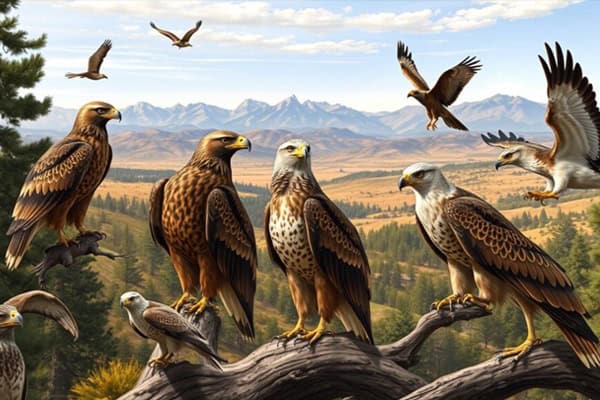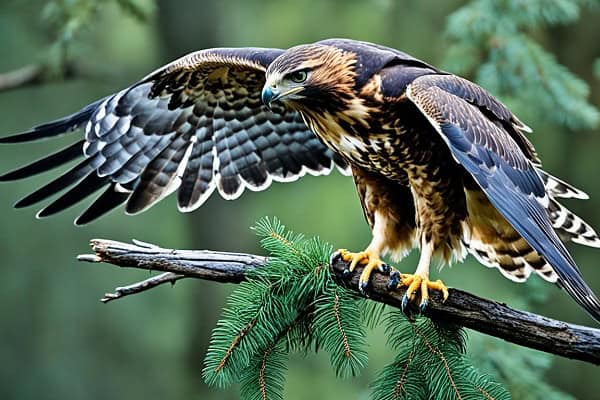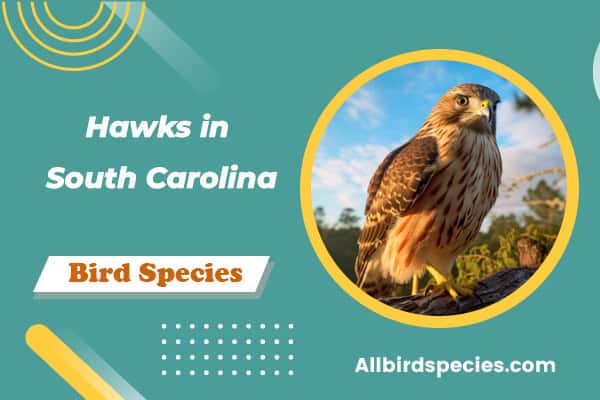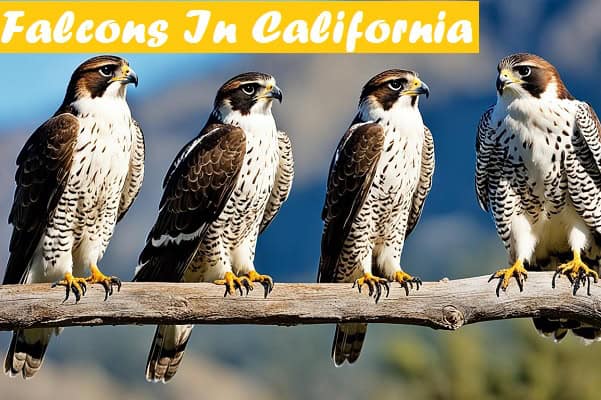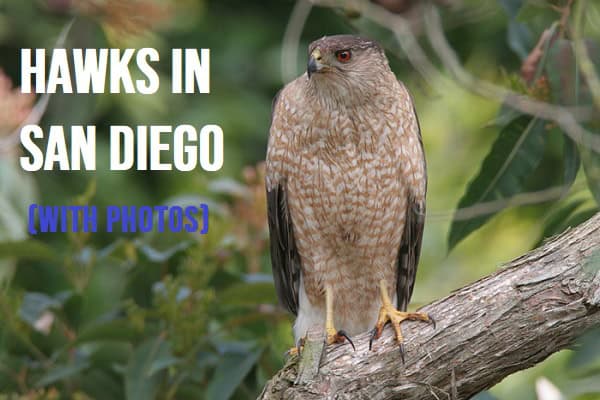Top 14 Most Common Hawks in California (With Photos)
Did you know California is home to over 20 hawks? About 14 of these can be found throughout the state. This makes California a great place to learn about hawks. We’ll explore the 14 most common hawks in California, including their unique features, behaviors, and where they live.
Join us as we learn about these amazing birds with photos that show their beauty. Whether you love birds or just want to know more, this journey into California’s hawks will be fascinating.
Common Hawks Found In California
- Red-tailed Hawk
- Ferruginous Hawk
- Harris’s Hawk
- Rough-legged Hawk
- Red-shouldered Hawk
- Northern Goshawk
- Cooper’s Hawk
1. Red-tailed Hawk
- Scientific name: Buteo jamaicensis
- Length: 45 to 60 cm
- Weight: 690 to 1,300 g
- Wingspan: 105 to 141 cm
- Lifespan: 6-10 years
The Red-tailed Hawk, known scientifically as Buteo jamaicensis, is a stunning bird of prey. It’s one of the most common raptors in California. Its unique features make it a favorite among birdwatchers and casual observers alike.

Identification Features
Identifying a Red-tailed Hawk is easy thanks to its eye-catching traits. Adults have a reddish-brown tail and plumage that varies from white to deep brown. They have a wingspan of 43 to 55 inches and are about 18 to 26 inches long. Their loud, distinctive scream is a familiar sound in the wild.
Habitat and Range
Red-tailed Hawks are adaptable birds. They live in many places, from cities to forests and fields. Their range covers all of California. You can see them flying high or sitting on tall trees or poles.
Diet and Hunting Behavior
These hawks mainly eat small mammals like mice, voles, and rabbits. They are skilled hunters, often waiting from high spots to spot prey. When they see prey, they dive sharply to catch it. They choose tall trees for their nests, which gives them a great view for hunting.
2. Sharp-shinned Hawk
- Scientific name: Accipiter striatus
- Length: 23 cm – 37 cm
- Weight: 82 to 219 g
- Wingspan: 58 to 68 cm
- Lifespan: 5-12 years
The Sharp-shinned Hawk, known scientifically as Accipiter striatus, is a small but agile raptor. It captures the hearts of birdwatchers in California. Its unique features and behavior make it a favorite among birdwatching fans.

Physical Appearance
This hawk is the smallest in its family in California. It ranges from 9 to 13.5 inches in length. The wingspan is between 16.5 and 26.5 inches. Its size makes it a joy to watch.
It has a bluish-gray back and orange bars on its upper chest. Males are smaller than females, making them harder to tell apart.
Common Locations
Sharp-skinned hawks live in wooded areas where food like songbirds is plentiful. Birdwatchers in California can easily spot them, especially near homes with bird feeders. They prefer areas with dense vegetation. This lets them move quickly and hunt effectively.
Hawks in other Regions:
3. Cooper’s Hawk
- Scientific name: Accipiter cooperii
- Length: 35 to 50 cm
- Weight: 7.8-14.5 oz
- Wingspan: 62 to 99 cm
- Lifespan: 5-10 years
Cooper’s Hawk, known scientifically as Accipiter cooperii, is a bird of prey that captures our interest. Its unique look and hunting skills make it a key part of California’s wildlife. Learning about its features and behaviors helps us appreciate this amazing bird more.
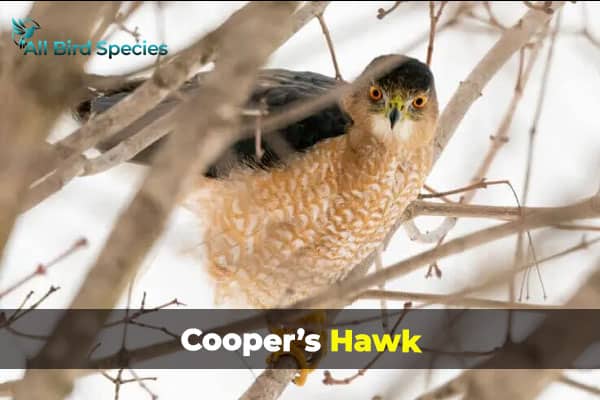
Identifying Characteristics
Identifying a Cooper’s Hawk is easy thanks to its size and feathers. They are 13.5 to 20 inches long and have wings that spread 24.5 to 35.5 inches wide. Their head is rounded, and they have blue-gray feathers on their back. The underparts are rufous-chested, making them stand out.
They are bigger than Sharp-shinned Hawks and have more visible markings. Their tail has broad dark bands, helping us spot them in the trees.
Behavioral Traits
Cooper’s Hawks are known for their agility and hunting skills. They mainly hunt smaller birds, which is a big part of their diet. Often, they can be seen near bird feeders, where they use their fast flight and quick dives to catch prey.
Their ability to move quickly through dense foliage is key to catching hard-to-reach birds. This shows how they use stealth and speed to hunt effectively in their environment.
4. Northern Goshawk
- Scientific name: Falco columbarius
- Length: 46 to 61 cm
- Weight: 357 – 2,200 g
- Wingspan: 89 to 105 cm
- Lifespan: 7-12 years
The Northern Goshawk, or Accipiter gentilis, is a stunning bird of prey. It is known for its impressive physical traits and hunting prowess. Found in dense forests, this raptor is often overlooked because it is elusive and prefers hidden habitats. Learning about the Northern Goshawk’s characteristics and features helps us see why it fascinates birdwatchers and naturalists.

Physical Traits and Appearance
The Northern Goshawk hawks of California are between 16 and 27 inches long, with a wingspan of 35 to 50 inches. It has a robust and compact body. Its striking dark head and deep red eyes make it stand out among other raptors. The bird has a grayish plumage pattern that helps it blend into the forest. These traits aid its hunting strategies.
Feeding Habits
The Northern Goshawk eats small mammals, birds, and reptiles. They are opportunistic feeders, changing their strategies based on what’s available. Their speed and agility in hunting make them effective predators in dense forests. This adaptability is key to their survival.
| Aspect | Description |
|---|---|
| Scientific Name | Accipiter gentilis |
| Size | 16-27 inches |
| Wingspan | 35-50 inches |
| Eye Color | Deep Red |
| Primary Diet | Mammals, Birds, Reptiles |
| Hunting Style | Rapid and Agile |
5. Red-shouldered Hawk
- Scientific name: Buteo lineatus
- Length: 38 to 58 cm
- Weight: 550-700 g
- Wingspan: 90 to 127 cm
- Lifespan: 7-12 years
We’re diving into the world of the Red-shouldered Hawks of Calofornia, a bird with striking looks and a knack for adapting. Known for its eye-catching calls and unique feathers, this raptor is a sight to behold. Let’s delve into what makes the Red-shouldered Hawk stand out and where it calls home.

Identification Marks
The Red-shouldered Hawk, scientifically known as Buteo lineatus, is a sight to behold. It sports a mix of rich colors, with a rufous underbelly and white underwings. These hawks are medium-sized, with lengths between 15-19 inches and a wingspan of 38-42 inches. Their loud call, often described as a “kee-ahh,” is a common sound in their habitats.
Preferred Habitat
Red-shouldered Hawks love wooded areas with open canopies, perfect for hunting. They’re found in various California bird habitats, showing their adaptability. These hawks also do well in suburban areas, hunting small mammals like squirrels. This shows their skill as both forest and suburban dwellers.
Related Video:
6. Rough-legged Hawk
- Scientific name: Buteo lagopus
- Length: 46–68 cm
- Weight: 600 to 1,660 g
- Wingspan: 120 to 153 cm
- Lifespan: 8-10 years
We admire the Rough-legged Hawk for its amazing migration and hunting skills. These birds travel thousands of miles from the Arctic to California. They go to open fields and grasslands to hunt.
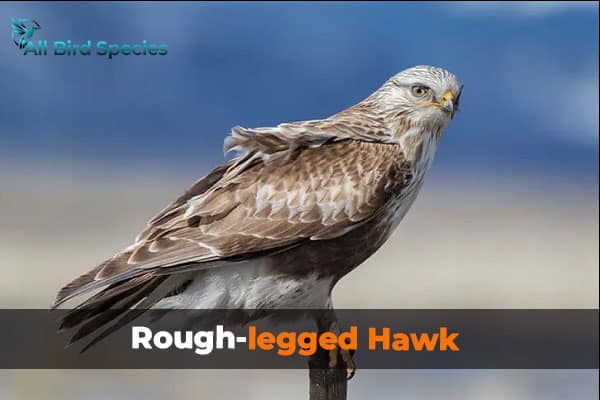
Migration Patterns
In the fall, Rough-legged Hawks leave the Arctic for warmer places. During winter, we see them in California, moving with great precision. They help control rodent populations, which is good for our ecosystems.
Seeing these Rough-legged Buzzards in the sky is truly moving. It fills us with wonder.
Distinctive Hunting Techniques
Rough-legged Hawks have unique hunting ways. They can hover in the air, looking for small mammals or other prey. This lets them stay still while watching everything below.
They also hunt by waiting or diving down on their prey. Watching them do this shows how well they’ve adapted to their world.
Hawks in California: Overview of Their Importance
Hawks are crucial to our ecosystems, playing a big role in keeping things balanced. These birds of prey help control rodent and small mammal populations. This stops pests from getting out of hand, which can cause environmental problems.
Learning about hawks shows how they affect biodiversity. They are good indicators of a healthy environment. If hawks are doing well, it means the ecosystem is strong with enough food and good living conditions. But if their numbers go down, it could mean there are environmental issues that need fixing.
Hawks are important for more than just hunting. They act as key signs of how healthy our ecosystems are. By watching their behavior and numbers, we can see how well our conservation efforts are working. This helps us know where we need to make changes fast.
- Control rodent populations and small mammals.
- Act as indicators of environmental health.
- Contribute to biodiversity by maintaining ecological balance.
| Aspect | Significance |
|---|---|
| Predation | Controls pest populations, ensuring ecological balance. |
| Environmental Indicators | Reflects habitat health and biodiversity levels. |
| Conservation | Aids in determining the success of conservation efforts. |
Other Notable Hawks in California
California is home to many hawk species, each with unique traits and behaviors. We’ll focus on two notable hawks: the Harris’s Hawk and the Ferruginous Hawk. These birds are fascinating because of their distinct looks and interesting ways of living.
7. Harris’s Hawk
- Scientific name: Parabuteo unicinctus
- Length: 46 to 59 cm
- Weight: 546 to 850 g
- Wingspan: 103 to 120 cm
- Lifespan: 10-12 years
The Harris’s Hawk, known as Parabuteo unicinctus, is known for its social hunting. These birds often fly together, showing off their teamwork during hunts. They have dark brown feathers with rich rufous tones. They live in open deserts, where they can hunt freely.
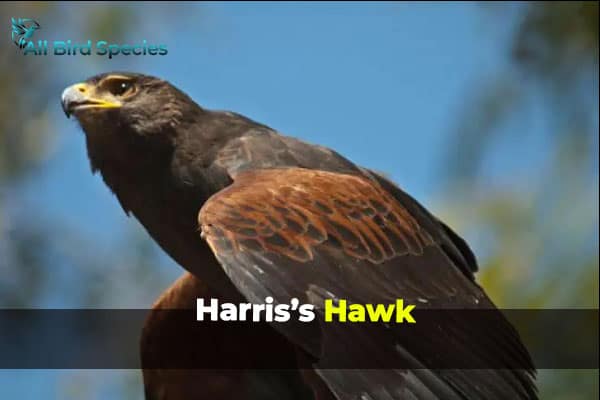
Their behavior and group activities make them stand out among other hawks.
8. Ferruginous Hawk
- Scientific name: Buteo regalis
- Length: 51 to 71 cm
- Weight: 907 to 2,268 g
- Wingspan: 122 to 158 cm
- Lifespan: 8-12 years
The Ferruginous Hawk, or Buteo regalis, is big and has beautiful rusty feathers. It has broad wings and a strong presence. These hawks live in grasslands and open areas, perfect for hunting.

They mainly eat small mammals, showing their hunting skills. Seeing a Ferruginous Hawk in flight is a sight to behold.
Conservation Status of Hawks in California
Exploring the conservation status of hawks in California shows many species face big challenges. These come from losing their homes, climate change, and human actions that harm their habitats. It’s vital to tackle these hawk population threats to help these birds survive.
Threats to Hawk Populations
Hawks in California face threats like:
- Habitat destruction from cities and farms growing
- Pesticide poisoning from chemicals used to kill pests
- Crashing into vehicles while hunting near roads
More cities mean less space for hawks to live and hunt. This makes their future look grim.
Conservation Efforts
Groups working to save California hawks are key to their protection. They do things like:
- Restoring their homes through conservation efforts
- Teaching the public about protecting raptors in California
- Studying hawks to understand what they need
With these bird protection initiatives, we can help hawks bounce back. Saving endangered species takes teamwork to make the environment better for our raptors.
| Threats | Conservation Actions |
|---|---|
| Habitat Loss | Restoring natural areas through conservation programs |
| Pesticide Poisoning | Implementing regulations to limit chemical use |
| Vehicle Collisions | Creating awareness campaigns to reduce roadside hunting |
Photography Tips for Spotting Hawks
When we start taking pictures of hawks, we need to use smart strategies. First, look for places with lots of nature like grasslands, forests, and wetlands. These spots are great for hawks to hunt.
Using telephoto lenses lets us get close to hawks without bothering them. This is key for good bird photography. A zoom lens brings hawks closer but still lets them act naturally, making photos more interesting.
Knowing how hawks behave is also key for great photos. Watching their flight patterns helps us guess where they’ll go next. This info helps us catch those perfect moments, making hawk photography easier.
- Scout locations with abundant wildlife cover.
- Use a telephoto lens for close-up shots.
- Study hawk behavior to predict flight paths.
- Be patient and ready for unexpected photographic opportunities.
Where to Find Hawks in California
For those of us passionate about birding, finding the best places to see hawks in California is exciting. This state has many places where hawks live and visit all year. National parks and wildlife refuges are great spots to see these birds up close.
Some top places for hawk watching include:
- San Joaquin Valley: Known for its rich raptor populations, this area is a hotspot during migratory seasons.
- Point Reyes National Seashore: The coastal winds create ideal conditions for many hawks, especially during fall migrations.
- Los Padres National Forest: Diverse ecosystems support a range of hawks, making this a wonderful place for birding enthusiasts.
When we visit these places, we should look for open fields. Hawks often hunt in these areas. This allows us to see their hunting skills and aerial displays. Whether you’re an experienced birder or new to the hobby, these spots offer memorable moments with California’s hawks.
Check Our Previous Articles:
| Orange and Black Birds in Colorado |
| Sparrows in Ohio |
| Hawks in Michigan |
| Black Birds With Yellow Beaks |
| Hummingbirds in Illinois |
Conclusion
Our journey into California hawks has shown us their amazing diversity and importance. We’ve learned about the Red-tailed Hawk and the Northern Goshawk. These birds are not just beautiful; they play a key role in our ecosystems.
They help keep our surroundings balanced by controlling rodent populations. Hawks also tell us about the health of our environment. Understanding their importance shows us how vital they are to our world.

